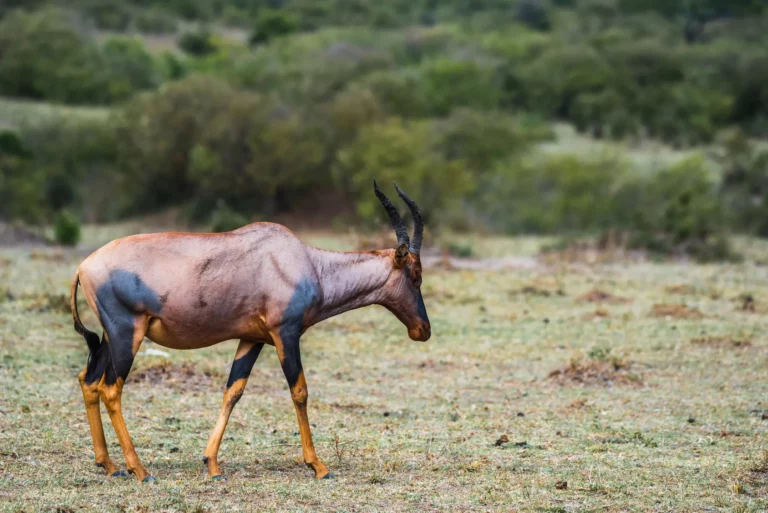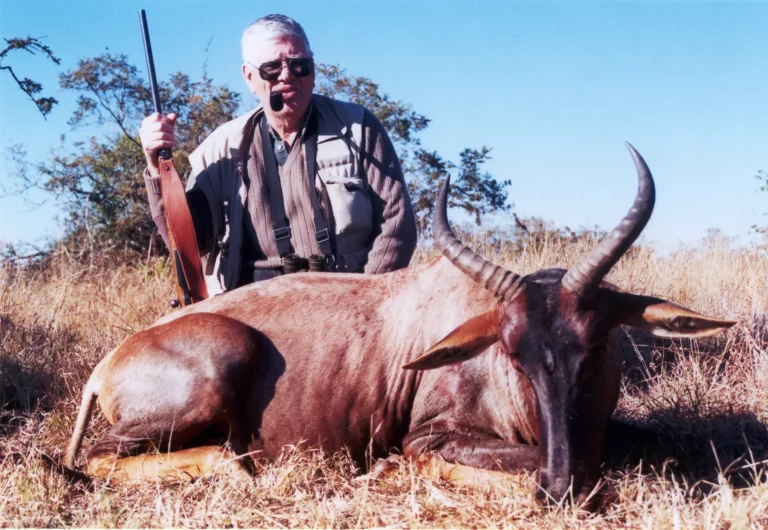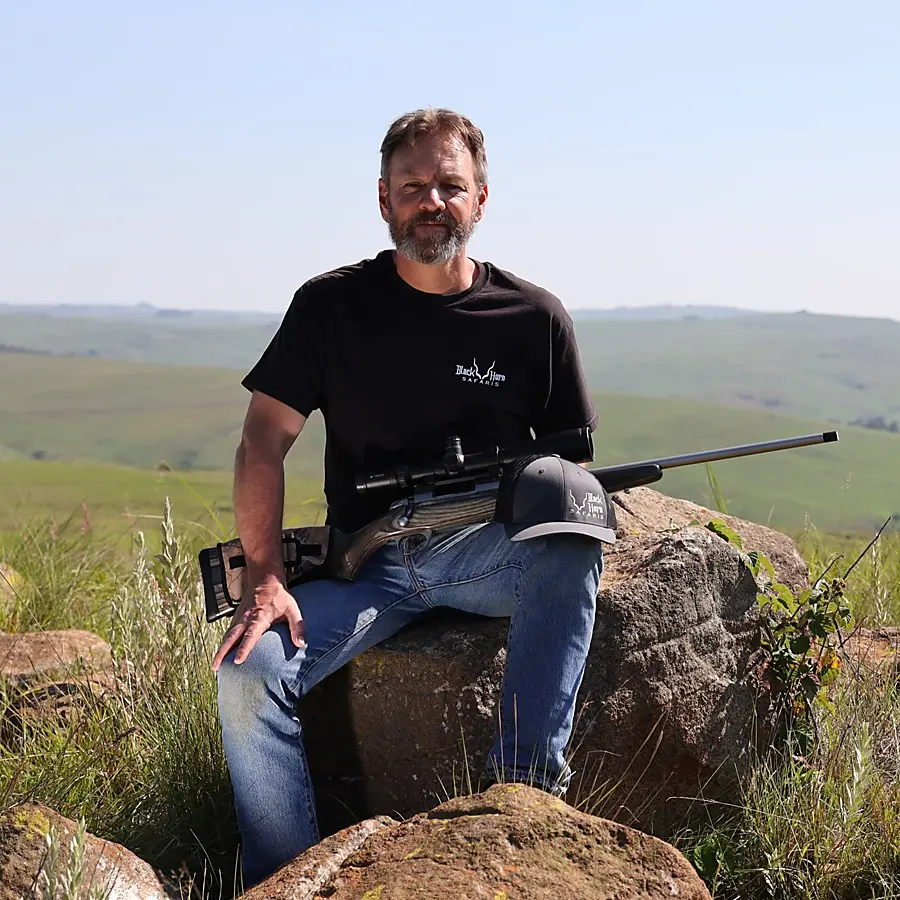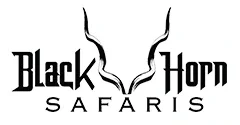Hunting Tsessebe, offers an opportunity for trophy collectors to acquire a unique African species, an antelope native to the grasslands of southern and eastern Africa. Known for their striking appearance, with a distinct hump at the shoulders and a long face, Tsessebes are among the fastest African antelopes, reaching speeds of up to 90 km/h. In this article we provide all the information necessary for planning a safari including prices, packages, the best areas and archery equipment.

Description and Characteristics
The Tsessebe, (Damaliscus lunatus lunatus)also known as the Sassaby in East Africa, is a large, robust antelope found primarily in the bushveld and grasslands of southern and eastern Africa. The species is notable for its unique appearance, it boasts a striking dark reddish-brown to purplish coat that contrasts sharply with its black face and hindquarters. The most distinctive feature is perhaps its humped shoulders and elongated face, giving it a somewhat unusual profile compared to other antelopes. Tsessebes are among the fastest antelopes in Africa, capable of reaching speeds up to 90 km/h. They are gregarious animals, usually found in small herds of 10 to 15 individuals, although larger groups may form around abundant fresh grazing. Tsessebe are primarily grazers, feeding on grass, and they show a preference for areas with freshly sprouted green grass. They are diurnal animals, most active during the cooler parts of the day. These animals are members of the plains game group.
Trophy Size
Tsessebe horns are lyre-shaped, curving outwards and then inwards, and are present in both bulls and females, although they are larger and thicker in the males. A good trophy Tsessebe typically measures between 12 to 15 inches in length, as measured along the curve of the horn. However, exceptional specimens can boast horn lengths over 15 inches. The base circumference of the horns is also a factor considered in trophy assessment, adding to the overall score for record-keeping purposes. The Tsessebe’s impressive horns, along with its unique physical attributes, make it highly coveted by trophy hunters. Minimum for entry into Rowland Wards record book is 15 and Safari Club International require a score of 40.
Best Locations for Tsessebe Hunts in South Africa
South Africa, with its diverse topography and rich wildlife heritage, offers several excellent locations. The Limpopo Province is renowned for its big game hunting, and is home to a number of private game reserves where Tsessebes are found in abundance. The North West Province, particularly areas around the Magaliesberg and Pilanesberg, also boasts excellent opportunities. Similarly, the vast plains and bushveld of the Free State provide ideal habitats for these speedy antelope. In the Eastern Cape, various private game farms and reserves offer hunting packages specifically for Tsessebe. Each of these areas offers a unique hunting experience, with varying terrain and vegetation, requiring hunters to adapt their strategies to be successful. It is crucial for prospective hunters to research and select a reputable hunting outfitter in these areas that promotes ethical hunting practices and contributes to conservation efforts when you hunt in South Africa.
Rifles and Calibers for Tsessebe Hunting
Choosing the right rifle and caliber is a criticall part of planning a Tsessebe hunt. As these animals are relatively large and robust, a medium powered rifle is typically recommended. The .308 Winchester, .30-06 Springfield, and .300 Winchester Magnum are all reliable choices that can deliver the needed knock down power with good shot placement. The 7mm Remington Magnum is another popular choice, known for its flat trajectory and reach. The specific choice of rifle and caliber should take into account the hunter’s comfort and proficiency with the firearm, as well as the expected shooting distances, which can vary depending on the terrain and hunting method. Regardless of the chosen caliber, it is essential to use quality bullets designed for deep penetration and reliable expansion, to ensure a quick and humane harvest. Bullet weights of around 180 grains will provide adequate performance when rifle hunting.
Rifle Scopes
Choosing the right rifle scope for Tsessebe can greatly influence the success of the hunt. Taking into account that Tsessebe are most active during the early morning and late afternoon, a scope that performs well in low-light conditions is a distinct advantage. Look for scopes with large objective lenses, typically around 40 to 50mm, as these allow more light into the scope for better clarity at dawn and dusk. The magnification required will depend on the terrain and typical shooting distances expected. In open grasslands where long shots are common, a variable power scope with a high end magnification of around 12x to 15x can be beneficial. For closer ranges in bushveld conditions, a scope with lower magnification, say 4x to 8x magnification, should suffice. Key features to consider include the quality of the optics, durability, and the type of reticle. A high-quality, rugged scope with a simple but versatile reticle, such as a duplex or BDC reticle (Bullet Drop Compensator), is often a good choice for Tsessebe.
Shot Placement
Proper shot placement is an important aspect of an Africa hunt, not only to ensure a successful hunt but also to deliver a quick and humane kill. When hunting Tsessebe, two of the most effective shots are the broadside and the quartering away shots. A broadside shot provides a large target area and allows for the greatest chance of hitting vital triangle. The ideal aim point is midway up the body and slightly behind the shoulder, targeting the heart and lungs. This shot should put the animal down quickly and humanely.
The quartering away shot, where the animal is positioned at an angle facing away from the hunter, is another reliable option. This shot angle allows for the bullet to pass through the lungs, increasing the chances of a clean kill. The aiming point for a quartering away shot is to have the bullet exit on the far offside shoulder, angling the shot forwards into the vitals. This shot should penetrate the lungs and potentially the heart, offering an ethical kill. Regardless of the shot chosen, it is essential for the hunter to be patient and wait for the right shot opportunity before taking the shot.

Bow Hunting Tsessebe
Bow hunting Tsessebe is a unique and thrilling challenge that demands a different set of skills and strategies compared to a rifle. Given the Tsessebe’s keen senses and ability to move, getting within bow range requires patience, stealth, and an understanding of the animal’s behavior. Stalking, although possible, can be incredibly challenging due to the open habitat that Tsessebes often inhabit, and their tendency to be constantly on the move.
Shooting from a bow blind tends to yield the highest success rates for bow hunters. Constructing a blind near water sources or feeding areas is the most effective strategy, as Tsessebes, like all animals, need to drink and eat regularly. By setting up a blind downwind from these areas, a hunter can wait for the Tsessebes to come within range, often within 20 to 30 yards, ideal for a bow shot.
The key to a successful bow hunt is patience, waiting for the animal to present a broadside or slightly quartering away shot for the best chance at hitting the vital organs. Shot placement is even more critical in bow hunting, as the arrow needs to penetrate the Tsessebe’s rib cage and reach the heart or lungs for a clean, ethical kill. A bow with a draw weight of at least 60 pounds, coupled with a razor sharp broad head, is recommended.
Bow Hunting Equipment
Bow hunting Tsessebe in the wild bushveld of Africa demands not just skill and patience, but also the correct equipment to get the job done.
While the choice between a compound bow and traditional recurve bow often comes down to personal preference, most Tsessebe hunters opt for the compound bow. This is due to its superior power, accuracy, and let-off which allows the hunter to hold the bow at full draw for longer periods without fatigue. It’s recommended to have a bow with a draw weight of at least 60-70 pounds to ensure enough kinetic energy for a clean, ethical kill.
The choice of arrows and broad heads is equally important. Carbon fiber arrows are generally preferred for their balance of speed, weight, and durability. A finished arrow weight of 450-500 grains is ideal. When it comes to broad heads, fixed-blade or mechanical types can both be used. However, fixed-blade broad heads are often recommended for their reliability and penetration. Ensure your broad heads are sharp and have a cutting diameter of at least one and a quarter inch to maximize damage to the vital organs.
Hunting Prices and Costs of a Safari
The standalone trophy fee or price to hunt a Tsessebe is $ 3 250.
This price does not include the day fee of $ 350 per hunter per day, hunting 2 on 1 (Two hunters sharing one Professional Hunter).
A five day hunt including the day fee and trophy fee will cost $ 5 000.
Packages in South Africa
A Tsessebe, Gemsbuck and Blue Wildebeest hunting package will cost $ 8 550.
This is a 7 day package including a trophy Tsessebe, Gemsbuck and a Blue Wildebeest.
Included in this package hunt:
- Accommodation in a hunt lodge
- Meals
- Water and soft drinks
- The services of a Professional Hunter
- Field preparation of trophies
- Delivery of trophies to the Taxidermist
- Road transportation to and from Johannesburg International Airport
This is a fully guided hunt.
FAQ’S Frequently asked Questions
What does it cost to hunt Tsessebe?
The standalone trophy fee or price to hunt a Tsessebe is $ 3 250.
A five day hunt including the day fee and trophy fee will cost $ 5 000.
Where is the best area to find Them?
The Limpopo Province has a number of private game reserves and concessions where Tsessebes are abundant. Limpopo also consistently produces top trophy quality Tsessebe every year.
What is the best rifle caliber for Tsessebe?
The best rifle caliber of Tsessebe is the .300 Winchester Magnum which delivers the necessary knock down power and with good shot placement will reliably put down this species in a quick and efficient manner. Always se premium quality, controlled expansion soft point ammunition of 180 grains for an African hunting Safari.

Adrian Anderson first obtained his Professional Hunters license in 1991. He is a Big Five and Dangerous Game licensed Professional Hunter and Hunting Outfitter. He has a tremendous love for wildlife and the African bush and enjoys sharing his knowledge with the hunting clients that he guides. Guiding hunters in Africa’s wild places is a passion and seeing them succeed with their goals brings satisfaction. With knowledge of the Safari industry built up over 32 years he is well qualified to give guidance to his hunting clients.
